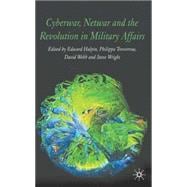
What is included with this book?
| List of Tables | x | ||||
| Preface | ix | ||||
|
|||||
| Notes on the Contributors | xiii | ||||
| Glossary | xvii | ||||
| Part I: Cyberwar, Netwar and the Revolution in Military Affairs: Defining the Issues | |||||
|
3 | (9) | |||
|
|||||
|
12 | (20) | |||
|
|||||
|
12 | (1) | |||
|
13 | (2) | |||
|
15 | (2) | |||
|
17 | (4) | |||
|
21 | (4) | |||
|
25 | (2) | |||
|
27 | (5) | |||
|
32 | (19) | |||
|
|||||
|
32 | (1) | |||
|
33 | (2) | |||
|
35 | (2) | |||
|
37 | (4) | |||
|
41 | (2) | |||
|
43 | (2) | |||
|
45 | (6) | |||
| Part II: Implications of the Problem | |||||
|
51 | (21) | |||
|
|||||
|
51 | (1) | |||
|
52 | (3) | |||
|
55 | (1) | |||
|
56 | (2) | |||
|
58 | (2) | |||
|
60 | (1) | |||
|
61 | (6) | |||
|
67 | (5) | |||
|
72 | (10) | |||
|
|||||
|
72 | (6) | |||
|
78 | (4) | |||
|
82 | (16) | |||
|
|||||
|
82 | (2) | |||
|
84 | (3) | |||
|
87 | (2) | |||
|
89 | (3) | |||
|
92 | (6) | |||
|
98 | (15) | |||
|
|||||
|
98 | (1) | |||
|
99 | (1) | |||
|
100 | (2) | |||
|
102 | (1) | |||
|
103 | (1) | |||
|
104 | (2) | |||
|
106 | (7) | |||
|
113 | (26) | |||
|
|||||
|
114 | (1) | |||
|
115 | (1) | |||
|
116 | (1) | |||
|
117 | (2) | |||
|
119 | (1) | |||
|
120 | (1) | |||
|
121 | (2) | |||
|
123 | (1) | |||
|
124 | (1) | |||
|
125 | (5) | |||
|
130 | (9) | |||
|
139 | ||||
|
|||||
|
139 | (2) | |||
|
141 | (3) | |||
|
144 | (7) | |||
|
151 | (6) | |||
| Part III: Country Perspectives | |||||
|
157 | (16) | |||
|
|||||
|
157 | (2) | |||
|
159 | (7) | |||
|
166 | (1) | |||
|
167 | (6) | |||
|
173 | (26) | |||
|
|||||
|
173 | (1) | |||
|
174 | (8) | |||
|
182 | (7) | |||
|
189 | (2) | |||
|
191 | (1) | |||
|
191 | (2) | |||
|
193 | (6) | |||
| Part IV: What is Being Done - or Must Be Done? | |||||
|
199 | (20) | |||
|
|||||
|
201 | (3) | |||
|
204 | (2) | |||
|
206 | (2) | |||
|
208 | (2) | |||
|
210 | (2) | |||
|
212 | (1) | |||
|
213 | (3) | |||
|
216 | (3) | |||
|
219 | (9) | |||
|
|||||
|
219 | (1) | |||
|
219 | (1) | |||
|
220 | (2) | |||
|
222 | (2) | |||
|
224 | (1) | |||
|
224 | (1) | |||
|
225 | (3) | |||
|
228 | (14) | |||
|
|||||
|
228 | (2) | |||
|
230 | (2) | |||
|
232 | (2) | |||
|
234 | (2) | |||
|
236 | (3) | |||
|
239 | (3) | |||
|
242 | (4) | |||
|
|||||
| Index | 246 |
The New copy of this book will include any supplemental materials advertised. Please check the title of the book to determine if it should include any access cards, study guides, lab manuals, CDs, etc.
The Used, Rental and eBook copies of this book are not guaranteed to include any supplemental materials. Typically, only the book itself is included. This is true even if the title states it includes any access cards, study guides, lab manuals, CDs, etc.